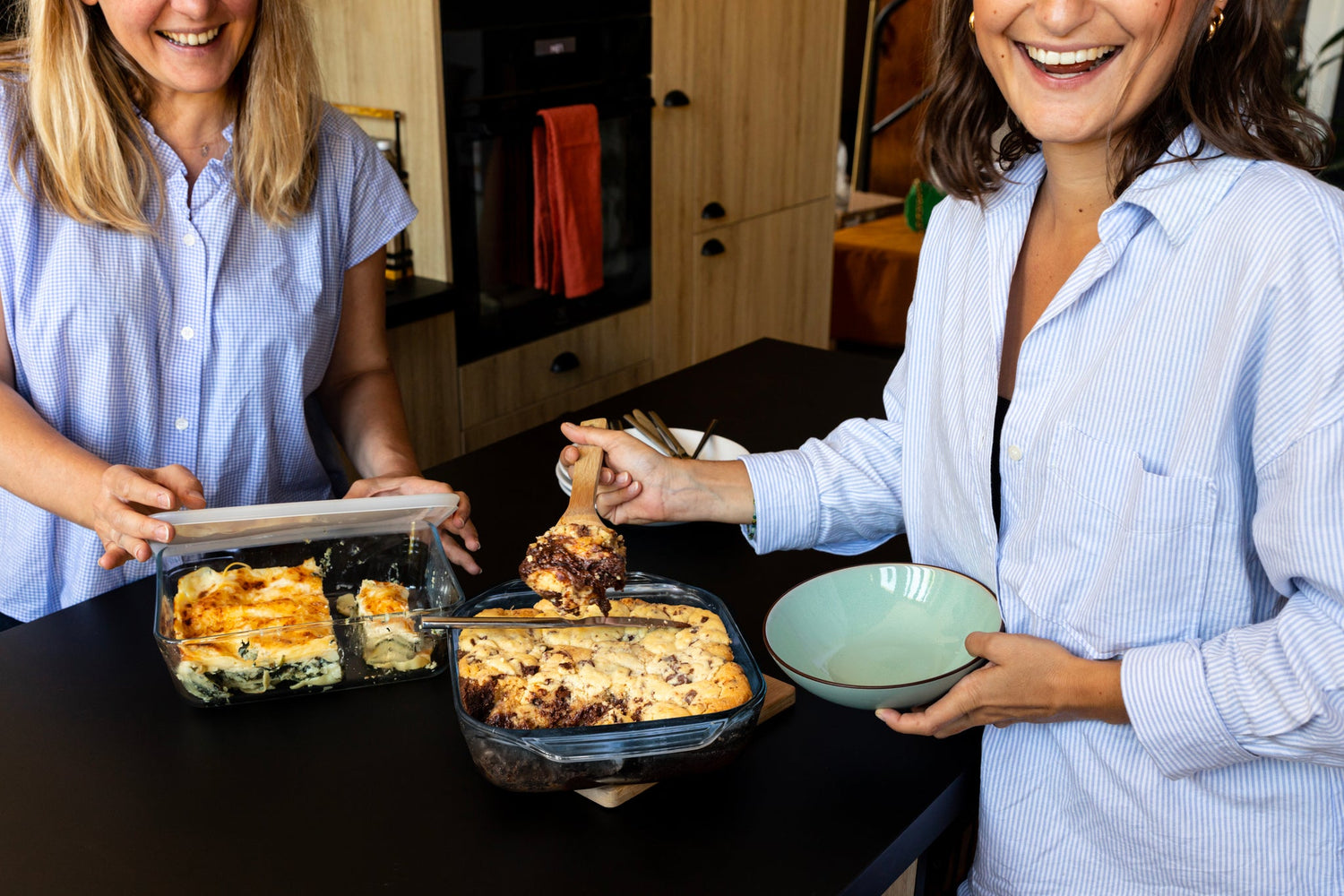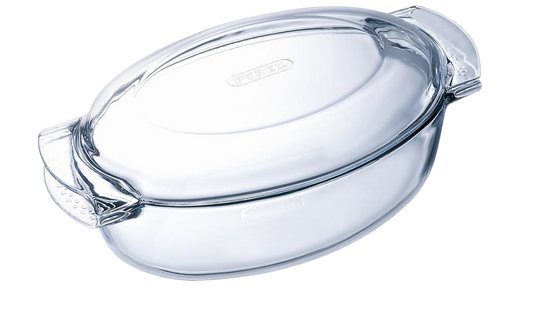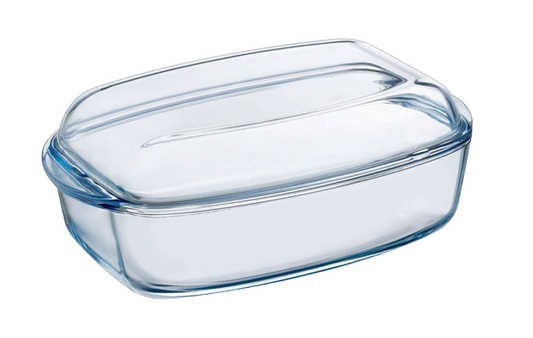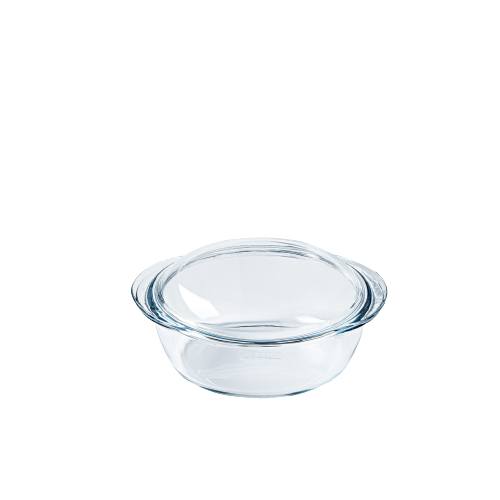How to choose the right casserole dish and why are they back in fashion?
At Pyrex®, we know what a trend is – and yet we don’t sell clothes. One thing is certain though: the French are spending more and more time in their kitchens. They are finding ways to offset rising food prices by preparing affordable, family-style meals that are above all healthy. This shift has brought casserole dishes back into the spotlight, whether made of cast iron, glass, stainless steel, ceramic or earthenware. But one key question remains when it comes to buying: which casserole dish should you choose?
Let’s take a closer look and help you find the answer.
Why cook with casserole dishes?
It’s a fair question to ask, especially when our worktops are filled with multi-cookers, steamers and air fryers using hot air instead of a traditional oven. But what about the classic casserole dish, whether oval or round? Quite simply, it allows gentle, even cooking through slow heat diffusion, making it perfect for stews and sauces – and depending on the type you choose, even bread and cakes.
If you’re still hesitating about buying a casserole dish, the following reasons should convince you.
A casserole dish lets you:
-
rediscover the authentic taste of traditional home-cooked meals,
-
braise, simmer, roast and slow-cook with ease,
-
prepare meat, poultry, fish, vegetables, bread or cakes,
-
cook gently at low heat to preserve the natural flavours of your food,
-
achieve great results even if you’re new to cooking,
-
use it safely in the oven,
-
keep it for years – and even pass it down from one generation to the next.
Cast iron, glass, ceramic or stainless steel: which casserole dish should you choose?
Convinced? Now it’s time to take a closer look at the different types of casserole dishes, their materials and their main pros and cons. That way, you’ll know whether to go for a glass casserole dish or a cast iron one.
The advantage of Pyrex® is that we offer several types of casserole dishes, all tried and tested, and built to last!
Cast iron casserole dish
Advantages of cast iron:
-
Extremely durable over time.
-
Suitable for all types of hobs, including induction.
-
Available with or without enamel coating, or in traditional raw cast iron.
-
Naturally inert and free from chemicals.
-
Ensures gentle, even heat distribution for simmering, braising, roasting and baking.
Disadvantages of cast iron:
-
Unfortunately heavy to handle.
-
Requires careful maintenance, especially traditional cast iron which can rust.
-
Enamel-coated versions are best used with wooden, plastic or silicone utensils.
-
Takes time to heat up to the right temperature.
-
More expensive to buy, but the cost pays off thanks to its long lifespan.
Glass casserole dish
Advantages of glass:
-
Withstands very high temperatures.
-
Can go in the fridge and resists sudden changes from hot to cold.
-
Affordable price.
-
Lighter than cast iron.
-
Lets you monitor cooking through the transparent sides.
Disadvantages of glass:
-
Cannot be used on direct flame or direct heat.
-
Only suitable for oven use.
-
More fragile, especially entry-level models.
► The key strength of Pyrex® glass casserole dishes: their proven resistance to shocks.
Ceramic or porcelain casserole dish
Advantages of ceramic or porcelain:
-
Does not retain smells or flavours from previous cooking.
-
Allows for healthy cooking.
-
Preserves the natural taste of food.
-
Lightweight.
-
Non-porous.
Disadvantages of ceramic or porcelain:
-
Not resistant to shocks.
-
Sensitive to sudden temperature changes.
-
Can become stained if the ceramic or porcelain is not of good quality.
Stainless steel casserole dish
Advantages of stainless steel:
-
Highly appreciated for its easy maintenance.
-
Extremely durable.
-
Does not rust, stain or warp.
-
Inert and does not react with food, even acidic ingredients.
-
Modern look that suits today’s kitchens.
-
Retains heat well, provided you choose one with a thick base.
Disadvantages of stainless steel:
-
Prone to scratches and abrasion from certain scouring pads.
-
Fairly expensive if you opt for a high-end model that will last for years.
-
Requires fat or oil to prevent food from sticking.
-
Tends to burn food easily, so cooking needs to be monitored regularly.
Clay or earthenware casserole dish
Advantages of clay or earthenware:
-
Guarantees healthy, traditional-style cooking.
-
Excellent heat distribution during cooking.
-
Optimises moisture and the natural water cycle.
-
Does not alter the taste of food.
Disadvantages of clay or earthenware:
-
Made from natural material, so fragile and not shock-resistant.
-
Often requires delicate maintenance.
-
Needs seasoning or preparation of the base before first use.
-
Usually designed without handles.
Which shape of casserole dish should you choose?
Casserole dishes generally come in two shapes: round and oval.
Choosing a round casserole dish
The round shape sits neatly on the hob, making it ideal for soups, vegetables and stews. It is best suited for families of 2 to 4 people.
Choosing an oval casserole dish
The oval shape is perfect for cooking larger cuts or long pieces, such as a whole chicken, pork tenderloin, roast or fish with vegetables. Note, however, that this shape can be less practical on some hobs, but it works perfectly in the oven.
Which size of casserole dish should you choose?
If you’re wondering which cast iron casserole dish or glass model is right for you, it really depends on the size of your household. Always check the capacity in litres, regardless of whether the dish is round or oval.
|
Number of people |
Casserole dish capacity |
|
1 à 2 people |
2 litres |
|
2 à 4 people |
3 à 5 litres |
|
4 à 6 people |
6 litres |
|
6 à 8 people |
8 litres |
|
More than 8 people |
10 to 12 litres |
Casserole dishes and hob compatibility
Not all casserole dishes are compatible with every type of hob. Today, most are suitable for induction cooking, except for glass casserole dishes which cannot withstand it, and clay dishes (such as tagines) which require a diffuser under the part exposed to heat.
The special role of lids
Casserole dishes are designed to be airtight, meaning water remains in a closed circuit during cooking. Pyrex® cast iron casserole dishes feature lids with internal spikes that capture condensation and release it in droplets, continuously basting the food throughout cooking. You can also add water to the outside of the lid to create extra humidity during the process.
How to care for your casserole dish
Always let your casserole dish cool down before washing or soaking to avoid thermal shock, and preferably wash it by hand. Dry it quickly rather than leaving it to air dry.
If food has stuck or slightly burned, fill it with hot water and add a tablespoon of baking soda before soaking.
Remember also to season cast iron casserole dishes regularly: coat with cooking oil and heat for 5 to 10 minutes on a medium hob.












